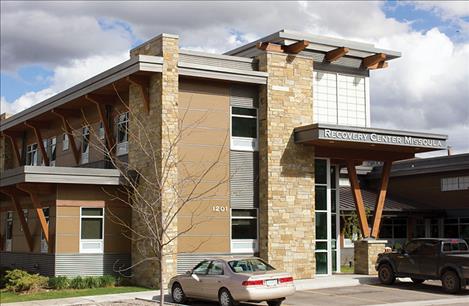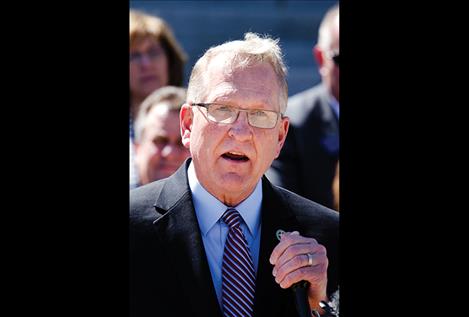Meth: state moves to increase access to treatment
Hey savvy news reader! Thanks for choosing local.
You are now reading
1 of 3 free articles.
Montana’s Attorney General stood on the steps outside of the Capitol in Helena and announced this state has a problem with drugs.
“You know it’s no secret that Montana has a substance abuse problem,” Attorney General Tim Fox said. “Since 1980 drug offense rates in Montana have increased 559 percent. From 2013 to 2016, the state crime lab has experienced a 143 percent in substance samples testing positive for methamphetamine and a 475 percent increase in substance samples testing positive for heroin.”
The main purpose is to create a roadmap for the legislature on drug-related bills when it meets again in 2019. To get there, Fox is planning listening sessions, meetings with people he identifies as “stakeholders” and a summit next fall. Together, he said these will lead to a complete plan on what Montana should do and do better when it comes to fighting substance abuse. Fox also made a point that Montana has to look beyond the courts and law enforcement to address the problem.
“While law enforcement will certainly be one method of addressing substance abuse, it certainly isn’t the only approach. Treatment, education and coordination efforts are critical if we are to get ahead of this problem,” Fox said.
Fox’s statement reflects what anyone involved with substance abuse will say. What works is treatment – a commitment that starts with a person’s willingness to get clean and then stay clean, usually in a place led by people trained to help addicts do that.
“I believe this is crucial just because it’s beautiful place for people to gain grounding and structure, and a foundation for their life to continue,” said a recovering meth addict in treatment.
He’s a 21-year-old who started doing meth when he was 15 and knew he couldn’t quit on his own. He asked to not be named in this story. He was wrapping up treatment at Recovery Center Missoula, which opened in 2013.
Recovery Center Missoula is the only state-approved treatment center serving Missoula County. That means it is the one center in Missoula that can apply for grants from the state, county funds and receive partial reimbursement from Medicaid to help people who want treatment, pay for treatment, even if they lack good insurance.
However, it only has room for the 21-year-old man and 15 others. Sixteen is the maximum number of beds the state allows in centers like this one.
“We really had to manage those beds well. And we could only take one or two people a month, who could access those state block grant funds. Because we have to keep our doors open. And state block grant and Medicaid only reimburse us 50 percent of what your charge is,” Tammera Nauts, executive director of Recovery Center Missoula, said.
Nauts added the wait to get into a center like this one can be long, especially if you can’t pay the out-of-pocket costs, which can add up to $500 a day. Nauts said they currently have a waitlist of 140 people and every single one of them has Medicaid.
That’s the way it is across the state, in part because of a 40-year-old state law.
In the 1970s, legislators wanted to prevent the duplication of services. They also aimed to spread out treatment options from just cities into more rural areas. So, they passed a law saying each county could have one – and only one – state-approved treatment center. Then, in 2015, Montana joined other states in passing the Medicaid expansion tied to the Affordable Care Act. It brought coverage to 70,000 additional adults across the state. It also expanded what Medicaid would partially cover, including mental health and addiction treatment services.
“We treat a lot of Medicaid folks. A lot. So without that expansion, none of those people could have come in for services,” Nauts said.
Except the problem now is the access to treatment. The recent legislative session began to address the problem with a new law that takes effect the first of July. With it, Montana is getting rid of the limit of one state-approved treatment center per county. No one knows how many more centers could open.
In signing the law in late March, Gov. Steve Bullock noted the need to address access to treatment, saying, it “is critical in helping connect people to treatment as early as possible. This change in the law will increase the opportunity for thousands of Montanans to receive care in their communities when they need it most.”
Nauts agreed with the governor.
“When you look at it from the client purview hopefully if more people are able to offer more treatment services, there won’t be so long of a waitlist. Because even outpatient facilities have waitlists too,” she said. “So hopefully more people will be able to access treatment, and really that’s the bottom line, is what is going to happen to the client.”
But the law could have at least one negative impact for places like Recovery Center Missoula. They won’t be the only game in town.
“One way it could affect us, I guess negatively, would be if more inpatient services popped up around the state,” Nauts said. “Then our competition would increase and then we would have to step up our game on the market.”
Even with 16 beds, Nauts said, “We don’t rush people through. They’re here for services. They’re here for treatment and to embark on a life-changing mission. And you can’t rush that.”
So she supports more access for more people to get treatment. But she also sees potential problems arising in finding enough qualified professionals to provide that treatment.
“As this access to treatment bill opens the door to more services, we are going to have a crisis in workforce,” Nauts said. “That’s a big deal. Very concerned about that. We are already facing a lack of licensed addiction counselors in the state of Montana.”
Of course, there are treatment programs besides those able to bill Medicaid. The Rocky Mountain Treatment Center in Great Falls is another voluntary treatment option.
Jessica Hofer is a licensed addictions counselor who runs the horse therapy program there. She got into the field because of her personal experience with substance abuse. She was an addict who also needed help turning her life around. Except her treatment experience was quite a bit different from where she works now. For one thing, there were no horses.
“I went through a very prisonlike treatment facility. I requested a facility such as that because I knew for me, that’s what I needed,” Hofer said.
She’ll be sober nine years in November. Now she’s made a career out of helping others get clean, offering a gentler kind of treatment. For some, that’s what they need.
“You can’t engage in a power struggle with a horse. You’re not going to win. It doesn’t work out,” Hofer said. “It’s easy for another human to look at another human and say you don’t know me. You haven’t experienced what I have experienced in life. You can’t do that with a horse. It’s really hard to blame a horse. ‘It’s the horses fault,’ doesn’t work out as well.”
The new law means that places that approach treatment the way this center in Great Falls does could become state-approved. Administrative Assistant Teresa Appelwick says it’s on the table, but as of right now, the Rocky Mountain Treatment Center will continue to operate as it does – by treating people who pay out of pocket or through insurance.
Regardless of how people come to treatment, Hofer and other addiction counselors say what’s important is that once a person commits to changing, he should have access to a place that can help.
The young man back at the Missoula Recovery Center wakes up at 6:30 a.m. and starts his days with yoga. He’ll also have time for meditation and meetings with counselors and with alums – people who’ve gone through the program and stayed clean. What’s been most helpful for him are the Narcotics Anonymous meetings where people tell their own stories.
“You’ll see tears, you’ll see anger because of what they gone through, not expressing it towards others but just because like ‘awh man, that’s crazy, that’s awesome’ happy anger in a sense,” he said.
He’s in the middle of trying to become a statistic the attorney general didn’t cite when he stood on the steps in Helena talking about how bad Montana’s substance abuse problem is – the number of people who get access to treatment, complete treatment and live a new sober life.
(Editor’s note: this story is one of a series produced by University of Montana journalism students on the impact of methamphetamine use in Montana. Additional stories from The Meth Effect will publish in weeks to come. Stories come from Fort Belknap, Lake County, Bozeman, Helena and Missoula. More from the series can be found at metheffect.com.)

















